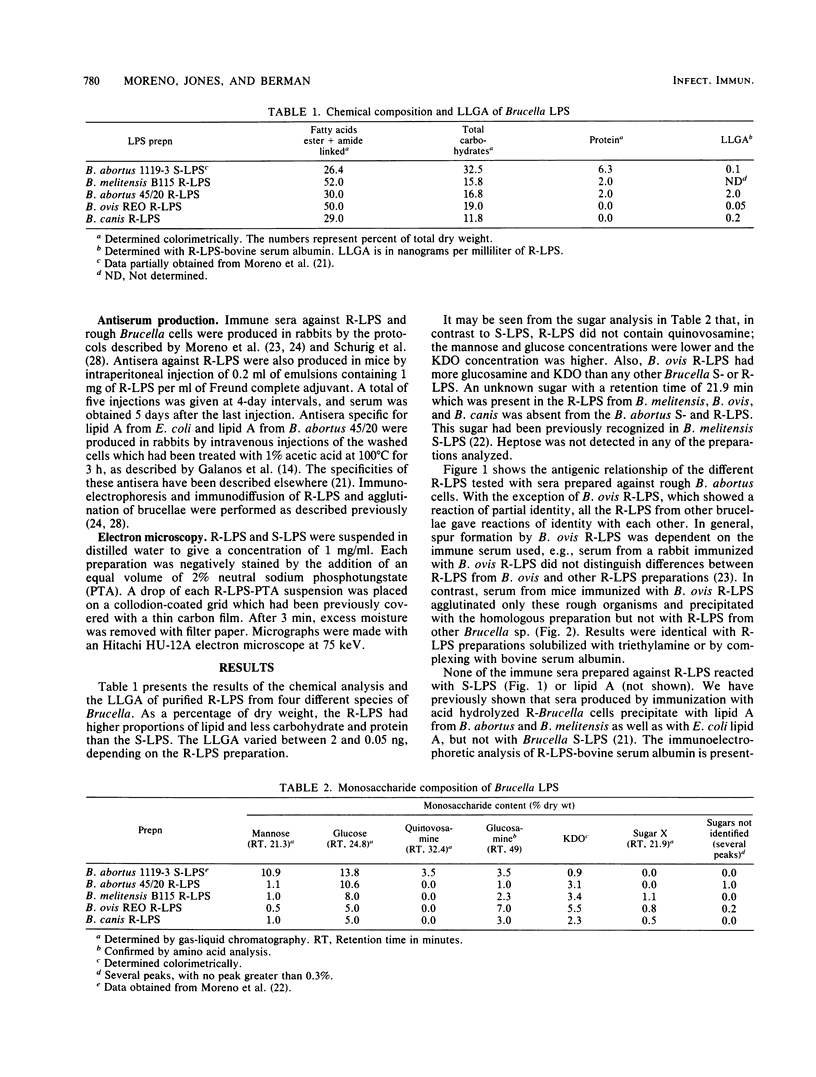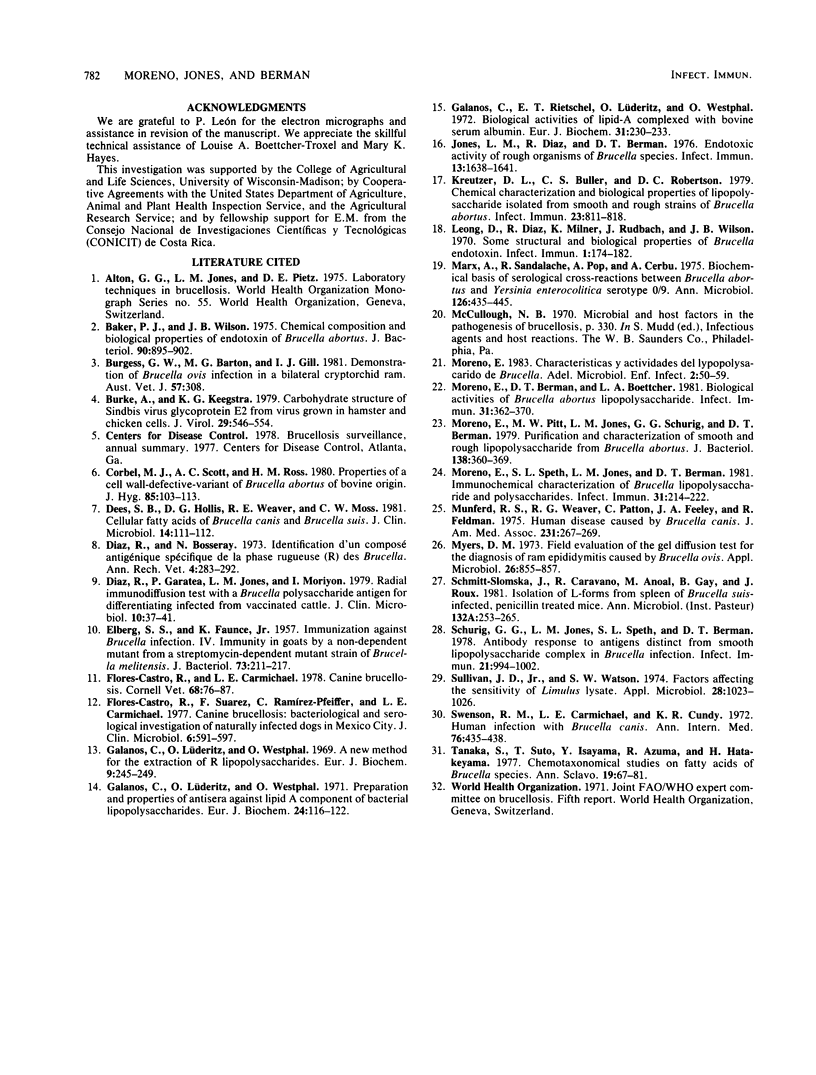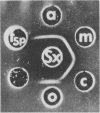Abstract
Lipopolysaccharides (LPS) were extracted from rough strains of Brucella abortus and Brucella melitensis and from strains of the naturally occurring rough species Brucella ovis and Brucella canis. Brucella rough lipopolysaccharides (R-LPS) were readily distinguished from Brucella smooth lipopolysaccharides (S-LPS) and enterobacterial R-LPS, by their chemical, physical, and serological characteristics. B. ovis R-LPS was differentiated from B. abortus, B. melitensis, and B. canis R-LPS by its reaction of partial identity in immunodiffusion. Monospecific mouse sera against B. ovis R-LPS agglutinated only the homologous bacteria but not R cells of other species of Brucella. B. ovis R-LPS contained more 2-keto, 3-deoxyoctonate, and glucosamine as a percentage of dry weight than any other R-LPS tested. B. abortus R-LPS was identified by the absence of an unidentified sugar present in the other R-LPS molecules, and B. melitensis R-LPS could be differentiated from B. canis R-LPS by its higher content of fatty acids. In contrast to S-LPS, all of the R-LPS studied lacked quinovosamine. In electron micrographs, Brucella R-LPS had a granular appearance, in contrast to typical lamellar structures formed by Brucella S-LPS and Escherichia coli R-LPS.
Full text
PDF



Images in this article
Selected References
These references are in PubMed. This may not be the complete list of references from this article.
- Baker P. J., Wilson J. B. Chemical composition and biological properties of the endotoxin of Brucella abortus. J Bacteriol. 1965 Oct;90(4):895–902. doi: 10.1128/jb.90.4.895-902.1965. [DOI] [PMC free article] [PubMed] [Google Scholar]
- Burgess G. W., Barton M. G., Gill I. J. Demonstration of Brucella ovis infection in a bilateral cryptorchid ram. Aust Vet J. 1981 Jun;57(6):308–308. doi: 10.1111/j.1751-0813.1981.tb05833.x. [DOI] [PubMed] [Google Scholar]
- Burke D., Keegstra K. Carbohydrate structure of Sindbis virus glycoprotein E2 from virus grown in hamster and chicken cells. J Virol. 1979 Feb;29(2):546–554. doi: 10.1128/jvi.29.2.546-554.1979. [DOI] [PMC free article] [PubMed] [Google Scholar]
- Corbel M. J., Scott A. C., Ross H. M. Properties of a cell-wall-defective variant of Brucella abortus of bovine origin. J Hyg (Lond) 1980 Aug;85(1):103–113. doi: 10.1017/s002217240002711x. [DOI] [PMC free article] [PubMed] [Google Scholar]
- Dees S. B., Hollis D. G., Weaver R. E., Moss C. W. Cellular fatty acids of Brucella canis and Brucella suis. J Clin Microbiol. 1981 Jul;14(1):111–112. doi: 10.1128/jcm.14.1.111-112.1981. [DOI] [PMC free article] [PubMed] [Google Scholar]
- Diaz R., Garatea P., Jones L. M., Moriyon I. Radial immunodiffusion test with a Brucella polysaccharide antigen for differentiating infected from vaccinated cattle. J Clin Microbiol. 1979 Jul;10(1):37–41. doi: 10.1128/jcm.10.1.37-41.1979. [DOI] [PMC free article] [PubMed] [Google Scholar]
- ELBERG S. S., FAUNCE K., Jr Immunization against Brucella infection. VI. Immunity conferred on goats by a nondependent mutant from a streptomycin-dependent mutant strain of Brucella melitensis. J Bacteriol. 1957 Feb;73(2):211–217. doi: 10.1128/jb.73.2.211-217.1957. [DOI] [PMC free article] [PubMed] [Google Scholar]
- Flores-Castro R., Carmichael L. E. Canine brucellosis. Current status of methods for diagnosis. Cornell Vet. 1978 Jan;68 (Suppl 7):76–88. [PubMed] [Google Scholar]
- Flores-Castro R., Suarez F., Ramirez-Pfeiffer C., Carmichael L. E. Canine brucellosis: bacteriological and serological investigation of naturally infected dogs in Mexico City. J Clin Microbiol. 1977 Dec;6(6):591–597. doi: 10.1128/jcm.6.6.591-597.1977. [DOI] [PMC free article] [PubMed] [Google Scholar]
- Galanos C., Lüderitz O., Westphal O. A new method for the extraction of R lipopolysaccharides. Eur J Biochem. 1969 Jun;9(2):245–249. doi: 10.1111/j.1432-1033.1969.tb00601.x. [DOI] [PubMed] [Google Scholar]
- Galanos C., Lüderitz O., Westphal O. Preparation and properties of antisera against the lipid-A component of bacterial lipopolysaccharides. Eur J Biochem. 1971 Dec 22;24(1):116–122. doi: 10.1111/j.1432-1033.1971.tb19661.x. [DOI] [PubMed] [Google Scholar]
- Galanos C., Rietschel E. T., Lüderitz O., Westphal O., Kim Y. B., Watson D. W. Biological activities of lipid A complexed with bovine-serum albumin. Eur J Biochem. 1972 Dec 4;31(2):230–233. doi: 10.1111/j.1432-1033.1972.tb02524.x. [DOI] [PubMed] [Google Scholar]
- Jones L. M., Diaz R., Berman D. T. Endotoxic activity of rough organisms of Brucella species. Infect Immun. 1976 Jun;13(6):1638–1641. doi: 10.1128/iai.13.6.1638-1641.1976. [DOI] [PMC free article] [PubMed] [Google Scholar]
- Kreutzer D. L., Buller C. S., Robertson D. C. Chemical characterization and biological properties of lipopolysaccharides isolated from smooth and rough strains of Brucella abortus. Infect Immun. 1979 Mar;23(3):811–818. doi: 10.1128/iai.23.3.811-818.1979. [DOI] [PMC free article] [PubMed] [Google Scholar]
- Leong D., Diaz R., Milner K., Rudbach J., Wilson J. B. Some structural and biological properties of Brucella endotoxin. Infect Immun. 1970 Feb;1(2):174–182. doi: 10.1128/iai.1.2.174-182.1970. [DOI] [PMC free article] [PubMed] [Google Scholar]
- Marx A., Sandulache R., Pop A., Cerbu A. Biochemical basis of the serological cross-reactions between Brucella abortus and Yersinia enterocolitica serotype O:9. Ann Microbiol (Paris) 1975 Dec;126(4):435–445. [PubMed] [Google Scholar]
- Moreno E., Berman D. T., Boettcher L. A. Biological activities of Brucella abortus lipopolysaccharides. Infect Immun. 1981 Jan;31(1):362–370. doi: 10.1128/iai.31.1.362-370.1981. [DOI] [PMC free article] [PubMed] [Google Scholar]
- Moreno E., Pitt M. W., Jones L. M., Schurig G. G., Berman D. T. Purification and characterization of smooth and rough lipopolysaccharides from Brucella abortus. J Bacteriol. 1979 May;138(2):361–369. doi: 10.1128/jb.138.2.361-369.1979. [DOI] [PMC free article] [PubMed] [Google Scholar]
- Moreno E., Speth S. L., Jones L. M., Berman D. T. Immunochemical characterization of Brucella lipopolysaccharides and polysaccharides. Infect Immun. 1981 Jan;31(1):214–222. doi: 10.1128/iai.31.1.214-222.1981. [DOI] [PMC free article] [PubMed] [Google Scholar]
- Myers D. M. Field evaluation of the gel diffusion test for the diagnosis of ram epididymitis caused by Brucella ovis. Appl Microbiol. 1973 Dec;26(6):855–857. doi: 10.1128/am.26.6.855-857.1973. [DOI] [PMC free article] [PubMed] [Google Scholar]
- Schmitt-Slomska J., Caravano R., Anoal M., Gay B., Roux J. Isolation of L-forms from the spleens of Brucella suis-infected, penicillin-treated mice. Ann Microbiol (Paris) 1981 May-Jun;132(3):253–265. [PubMed] [Google Scholar]
- Schurig G. G., Jones L. M., Speth S. L., Berman D. T. Antibody response to antigens distinct from smooth lipopolysaccharide complex in Brucella infection. Infect Immun. 1978 Sep;21(3):994–1002. doi: 10.1128/iai.21.3.994-1002.1978. [DOI] [PMC free article] [PubMed] [Google Scholar]
- Sullivan J. D., Jr, Watson S. W. Factors affecting the sensitivity of Limulus lysate. Appl Microbiol. 1974 Dec;28(6):1023–1026. doi: 10.1128/am.28.6.1023-1026.1974. [DOI] [PMC free article] [PubMed] [Google Scholar]
- Swenson R. M., Carmichael L. E., Cundy K. R. Human infection with Brucella canis. Ann Intern Med. 1972 Mar;76(3):435–438. doi: 10.7326/0003-4819-76-3-435. [DOI] [PubMed] [Google Scholar]
- Tanaka S., Suto T., Isayama Y., Azuma R., Hatakeyama H. Chemo-taxonomical studies on fatty acids of "Brucella" species. Ann Sclavo. 1977 Jan-Feb;19(1):67–82. [PubMed] [Google Scholar]






